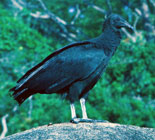 |
 |
 |
Articles
"A Tragedy for Humans and for Bears"
The tragic death of a 39 year old bear trainer in Southern California on Earth Day underscores the broader fate of a magnificent mammal that once ranged across most of North America. First described in 1509, at a time when there might have been millions of grizzlies, based upon various estimates of their needed food range, American culture has subsequently done much to ensure the doom of this long-lived largely vegetarian, engagingly maternal, non-territorial creature. Today the grizzly bear has been reduced to fewer than 2 per cent of its original domain. By the early 1900s, it is estimated there were no more than 50,000 grizzly bears remaining in the United States (the current population of Brown Bears, a different sub-species, throughout all of Europe and Russia). By 1924, California lost its last grizzly. Elsewhere, attrition has continued with great rapidity: Mexico's grizzly went extinct in 1960; the Canadian Prairie grizzly was deemed extinct as recently as 2002. Fewer than 1200 grizzly now remain in the lower 48 US states. If an equivalent attrition occurred amongst the 300 million U.S. citizens, today's human population would all be confined to one small city.
Throughout this ongoing massacre, grizzlies are known to have killed approximately 50 humans in that last 100 years.
A large number of captive grizzly bears is certainly no substitute for bears in the wild. Wrote John Muir, "In my first interview with a Sierra bear we were frightened and embarrassed, both of us, but the bear's behavior was better than mine." And as behaviorists have learned, a captive bear is totally unpredictable, because of her (not surprisingly high) potential for boredom, frustration and –we must assume- misery and anger at her plight. Add to these the bear's potent memory, and all the cumulative instincts which tell her that her situation is dire, and a seven hundred pound mammal with paws the size of a medium pizza, becomes the last creature on earth one would want to attempt to manipulate and "train".
Listed as Threatened by the Federal Government and, under rubrics of the 1973 Endangered Species Act, "likely to become an endangered species" this protective web has seen some success in Yellowstone, where the resident grizzly population was allowed to rebound from a very few dozen to approximately 500-to-600, but nowhere else. One way to ascertain the extreme plight of the grizzly is to see the bear's huge population fertility pulse –between 4-and-7 per cent annually- when given a chance to make a comeback.
But short of large ecosystem protection for one of North America's most impressive and –by all accounts, eccentric and normally gentle and shy creatures- these great beings need, at the very least, quality sanctuary. The Bear Center at Washington State University is one such locale where orphaned cubs can be treated with the respect they deserve and demand. And where non-invasive research can humbly remind us that we do not own other species; they are not our's to exploit; and that we must take every possible stride to reconcile our needs and their's, ensuring blueprints for co-habitation, re-wilding, and re-enchantment. We are an interdependent family of beings.
Copyright 2008 by Michael Tobias
 BACK TO TOP
BACK TO TOP
 |
|
 |
|
"A Tragedy for Humans and for Bears"
The tragic death of a 39 year old bear trainer in Southern California on Earth Day underscores the broader fate of a magnificent mammal that once ranged across most of North America. First described in 1509, at a time when there might have been millions of grizzlies, based upon various estimates of their needed food range, American culture has subsequently done much to ensure the doom of this long-lived largely vegetarian, engagingly maternal, non-territorial creature. Today the grizzly bear has been reduced to fewer than 2 per cent of its original domain. By the early 1900s, it is estimated there were no more than 50,000 grizzly bears remaining in the United States (the current population of Brown Bears, a different sub-species, throughout all of Europe and Russia). By 1924, California lost its last grizzly. Elsewhere, attrition has continued with great rapidity: Mexico's grizzly went extinct in 1960; the Canadian Prairie grizzly was deemed extinct as recently as 2002. Fewer than 1200 grizzly now remain in the lower 48 US states. If an equivalent attrition occurred amongst the 300 million U.S. citizens, today's human population would all be confined to one small city.
Throughout this ongoing massacre, grizzlies are known to have killed approximately 50 humans in that last 100 years.
A large number of captive grizzly bears is certainly no substitute for bears in the wild. Wrote John Muir, "In my first interview with a Sierra bear we were frightened and embarrassed, both of us, but the bear's behavior was better than mine." And as behaviorists have learned, a captive bear is totally unpredictable, because of her (not surprisingly high) potential for boredom, frustration and –we must assume- misery and anger at her plight. Add to these the bear's potent memory, and all the cumulative instincts which tell her that her situation is dire, and a seven hundred pound mammal with paws the size of a medium pizza, becomes the last creature on earth one would want to attempt to manipulate and "train".
Listed as Threatened by the Federal Government and, under rubrics of the 1973 Endangered Species Act, "likely to become an endangered species" this protective web has seen some success in Yellowstone, where the resident grizzly population was allowed to rebound from a very few dozen to approximately 500-to-600, but nowhere else. One way to ascertain the extreme plight of the grizzly is to see the bear's huge population fertility pulse –between 4-and-7 per cent annually- when given a chance to make a comeback.
But short of large ecosystem protection for one of North America's most impressive and –by all accounts, eccentric and normally gentle and shy creatures- these great beings need, at the very least, quality sanctuary. The Bear Center at Washington State University is one such locale where orphaned cubs can be treated with the respect they deserve and demand. And where non-invasive research can humbly remind us that we do not own other species; they are not our's to exploit; and that we must take every possible stride to reconcile our needs and their's, ensuring blueprints for co-habitation, re-wilding, and re-enchantment. We are an interdependent family of beings.
Copyright 2008 by Michael Tobias

